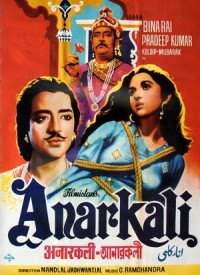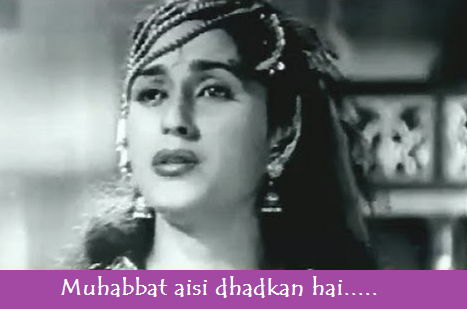Raaga Based Song of the Day: Mohabbat aisi dhadkan hai…
Raag Rageshri, Tal Kaherava
We have completed twenty-six days of Raaga Based Songs of the Day. Our first post in the series was titled ‘Raaga Based Song Of The Day #1’ and the song was a Mohammad Rafi and Lata Mangeshkar song from the 1970 Shakti Samanta movie Pagla Kahin Ka: Tum mujhe youn bhula na paoge. It is in Raag Jhinjhoti, Tal Kaherava.
Our twenty-sixth post was titled ‘Raaga Based Song Of The Day #26’ and the song was a Hemant Kumar song from the 1952 Guru Dutt movie Jaal: Ye raat ye chandini phir kahan. It is in Raag Kafi, Tal Kaherava.
This blog has a number of posts on Raaga based songs in Hindi movies titled similarly; for example: ‘The Best Raaga Based Songs in Hindi Movies – Raaga Bhimpalasi – Part I’.
In the last twenty-six days of sharing Raaga based songs of the day, I have given you songs based on Raag Jhinjhoti, Gara, Bhimpalasi, Madhuvanti, Shivaranjani, Bihag, Pahadi, Sarang, Pilu, Bhairavi, Khammaj, Charukesi, Kalyan or Yaman, Desh, Malgunji, Kirwani, Kedar, Bageshri, Megh Malhar, Bhupali, Ahir Bhairav, Malkaush, Adana, and Kafi.
Today, I give you a song in Raag Rageshri, Tal Kaherava.
However, first, lets take up the value added learning of today. Today, we shall learn about something called a Lehar or literally Wave:
If any of you have listened to Ghulam Ali sing his famous ghazal Dil mein ik lehar si uthi hai abhi, you would have heard the rendition of the word Lehar in various beats making you get the feel of different types of waves.
Generally, in a raaga or musical performance, the tabla is repetitive as accompaniment to main musicians. However, in a Lehar, the Tabla (or even Pakhwaj) is solo and the main musicians (sitar, harmonium or sarangi players), in a reversal of roles, have to improvise to keep tempo with the tabla. What is Lehar then? Lehar is what these main musicians play to keep pace with the tabla. It would be easy to make out that these musicians would do the same in Kathak recital too. The level of difficulty for the musicians is enormous as they have to understand the changing rhythm of the tabla.
In some part of the country, Lehar is just called naghma. In certain performances, erroneously, the tabla solo is called Lehar. I have clarified that it is the accompanying melody rendered by the main musicians.
Lehars can be three or six beat (Dadra, for example), four and eight beat (Kaherava), seven beat (Rupaktal), ten beat (Jhaptal), eleven beat (Chartal-ki-Savari), twelve beat ( Ektal), thirteen beat (Chandrachautal), fourteen beat (Dipchandi), fifteen beat (Pancham Savari), sixteen beat (Tintal), seventeen beat (Vishnutal), eighteen beat (Mattatal), nineteen beat (Purnatal) and twenty-one beat (Mansijtal).
As I told you, today’s song is composed in Raag Rageshri. We did one in Bageshri earlier, on the 19th day: Jao jao Nand ke Lala, an exquisite dance on that number by the best dancer in Hindi movies ever: Vyjayanthimala. But, Raag Bageshri and Rageshri, although similar sounding, are two very different raagas; the former belongs to the Kafi Thaat and the mood that it evokes is of a woman waiting to have reunion with her lover. It is a late night raaga. Rageshri, on the other hand, belongs to Khammaj Thaat, even though it too is to be sung in the second prahar of the night (9 pm to midnight). I have already told you that the Khammaj evokes sensuous feelings, even flirtatious.
Here are some of the other songs composed in Raag Rageshri:
| 1. 2. 3. 4. 5. 6. 7. 8. |
Shubh Din Aayo Kaun Aaya Mere Mohe Chhedo Na Kanha Jaadu Bhare Tore Naina Des Chhudaye Bhes Zindagi Khwab Hai Prabhu Charanon Mein Mane Na |
Mughal-E-Azam Dekh Kabira Roya Aaj Aur Kal Jaadunagari Chacha Zindabad Jaagte Raho Andolan Jaagir |
Bade Ghulam Ali Khan Manna Dey Asha Asha, Mahendra Kapoor Kishore Mukesh Parul Ghosh Lata |
 Today’s song is from the 1953 iconic movie Anarkali (some seven years before K Arif’s magnum opus Mughal-e-Azam on the same story/theme), a movie on the life and love of a courtesan Nadira (popularly known as Anarkali, the blossom of Pomegranate) with the prince to Emeperor Akbar: Salim (who was later to become Jehangir). The movie was directed by Nandlal Jaswantlal and starred Bina Rai in the title role and Pradeep Kumar as Salim.
Today’s song is from the 1953 iconic movie Anarkali (some seven years before K Arif’s magnum opus Mughal-e-Azam on the same story/theme), a movie on the life and love of a courtesan Nadira (popularly known as Anarkali, the blossom of Pomegranate) with the prince to Emeperor Akbar: Salim (who was later to become Jehangir). The movie was directed by Nandlal Jaswantlal and starred Bina Rai in the title role and Pradeep Kumar as Salim.
Most of its songs are evergreen and were put together by Rajendra Krishan as Lyricist, and C Ramchandra as Music Director and Composer. However, this immortal and iconic song was penned by Hasrat Jaipuri, the undisputed King of Romance.
C Ramchandra came on the scene, Vasant Prakash was the Music Director who died whilst the movie was being made. C Ramchandra, because of his abiding love for Lata Mangeshkar, insisted that all female songs be sung by her. However, one song sung by Geeta Dutt was retained: Aa jaane wafa.
This one was sung by Lata Mangeshkar on a composition by C Ramchandra in Raag Rageshri, Tal Kaherava, on the lyrics of Hasrat Jaipuri and assumed proportions of being an iconic song on Love.
Please enjoy: Muhabbat aisi dhadkan hai….
Is i.ntezaar-e-shauk ko janamo.n kii pyaas hai
Ik shamaa jal rahii hai, to vo bhii udaas hai
Muhabbat aisii dha.Dakan hai, (jo samajhaaii nahii.n jaatii) – 2
Zubaa.n par dil kii bechainii, (kabhii laaii nahii.n jaatii) – 2
Muhabbat aisii dha.Dakan hai
Chale aao, chale aao, taqaazaa hai nigaaho.n kaa – 2
Taqaazaa hai nigaaho.n kaa
Kisii kii aarzuu aise, (to Thukaraaii nahii.n jaatii) – 2
Muhabbat aisii dha.Dakan hai, (jo samajhaaii nahii.n jaatii) – 2
Muhabbat aisii dha.Dakan hai
(Mere dil ne bichhaae hai.n sajade aaj raaho.n me.n) – 2
sajade aaj raaho.n me.n
Jo haalat aashiqii kii hai, (vo batalaaii nahii.n jaatii) – 2
Muhabbat aisii dha.Dakan hai, (jo samajhaaii nahii.n jaatii) – 2
Muhabbat aisii dha.Dakan hai
We have intended to learn about Raaga based music whilst we entertain ourselves with Raaga based songs. So, lets, once again, take stock of our collective learning so far:
- On the first day we learnt about the Raaga system devised by Pandit Vishnu Narayan Bhatkhande, which is the prevalent system in Hindustani Classical Music and based on ten Thaats.
- On the second day we learnt about Tal or Taal.
- On the third day we learnt about characteristics of Raagas that included Swar, Jati, Thaat, Arohana and Avarohana, Vadi, Samvadi and Pakad.
- On the fourth day, we learnt about Sargam.
- On the fifth day, we learnt about notations used in Indian classical music or simply Swar Lipi.
- On the sixth day, we learnt about the Ras (sentiments) that Raagas evoke.
- On the seventh day, we learnt about various types of Swar: Shuddha, Achal, Vikrut, Komal and Teevra.
- On the eighth day, we learnt the parts of a composition in Indian Classical Music.
- On the ninth day, we learnt the names of some of the popular instruments used in Indian Classical Music.
- On the tenth day, we learnt about the sources of names of Raagas.
- On the eleventh day, we learnt about why Bhairavi is the first raag to be taught to beginners and also why it is the last in a performance.
- On the twelfth day, we learnt about Khammaj Thaat.
- On the thirteenth day, we learnt about Tal Punjabi Theka or Sitarkhani.
- On the fourteenth day, we learnt about Alap.
- On the fifteenth day, we learnt about List of Raagas (Raagmala) in my favourite book: Sri Guru Granth Sahib.
- On the sixteenth day, we learnt about tips for raaga identification.
- On the seventeenth day, we learnt the basics of Gharana system.
- On the eighteenth day, we learnt about Filmi Sangeet.
- On the nineteenth day, we learnt about the commonest Tal in Raagas: Tintal.
- On the twentieth day, we learnt about the Kafi Thaat.
- On the twenty-first day, we learnt a little more in detail about the classification of Raagas.
- On the twenty-second day, we learnt the essential differences between Bhairavi and Bhairav.
- On the twenty-third day, we learnt a little more in detail about the Jati or Jaati of a raaga.
- On the twenty-fourth day, we learnt details of Thaat Bilawal, the most basic thaat in the Bhatkhande’s system of raagas.
- On the twenty-fifth day, we learnt about Tintal.
- On the twenty-sixth day, we learnt in detail about the Raaga – Samay linkage.
- And today, on the twenty-seventh day, we learnt about Lehar.
There is much more still to be learnt and enjoyed.
Please stay tuned!
